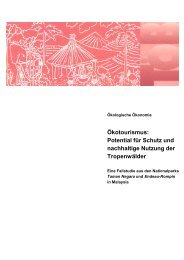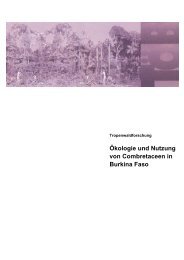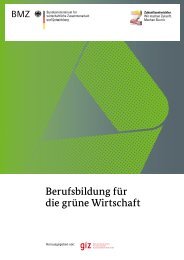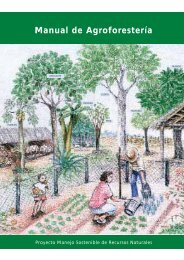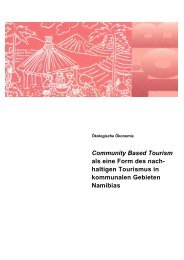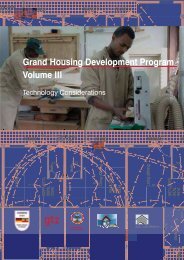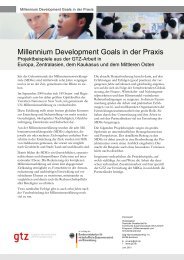Status Report on Global Neem Usage - Gtz
Status Report on Global Neem Usage - Gtz
Status Report on Global Neem Usage - Gtz
- No tags were found...
Create successful ePaper yourself
Turn your PDF publications into a flip-book with our unique Google optimized e-Paper software.
3. NEEM AS A NON-SYNTHETIC PESTICIDE• Use of neem as a home-made pesticide does not have high social status• Technical problems in processing and use as a home-made product• <strong>Neem</strong> raw materials can <strong>on</strong>ly be stored for a limited period in humid tropical c<strong>on</strong>diti<strong>on</strong>s.Many of the above drawbacks are closely related and could be remedied quite easily. Bydisseminating knowledge about neem, it is possible to do away with some restricti<strong>on</strong>s <strong>on</strong>use, such as doubts as to its effectiveness or the low esteem in which neem usage is held inmany societies. The problems associated with processing and applicati<strong>on</strong> could be resolvedwith specifically targeted promoti<strong>on</strong>, e.g. by state extensi<strong>on</strong> services.In many developing countries it is principally NGOs and small businesses which are active inspreading knowledge about neem and its uses. One advantage here is that the spread ofraw neem products does not require a large starting capital, nor sophisticated know-how.This means that a lot can be achieved even with very modest means (see examples given inChapter 4). This could also be a promising area for Technical Cooperati<strong>on</strong> (TC), e.g. inpromoting small and medium enterprises.Yet another complex obstacle to using neem is the insufficient number of neem seeds forproducing pesticides. However, professi<strong>on</strong>al marketing, be it of raw materials or ready-formulatedpesticides, could provide a way out of this dilemma. At the same time, in those regi<strong>on</strong>swith large stands of neem trees, there is the obvious opportunity of diversifying income.SOURCE: Own studies: MOSER, G (1996): <str<strong>on</strong>g>Status</str<strong>on</strong>g> <str<strong>on</strong>g>Report</str<strong>on</strong>g> <strong>on</strong> <strong>Global</strong> <strong>Neem</strong> <strong>Usage</strong>, GTZ.Chamberlain, J.R., Childs, F.J., and Harris, P.J.C. (1999): Results of <strong>Neem</strong> Electr<strong>on</strong>icWorkshop, 1-18 November, 1999. HDRA, Coventry, UK, 67pp. & Internet-e-mail/neemworkshop1999: www.hdra.org.uk/neem.htmJABBAR, A. ROBIN, H. & C. STRANG 1997: A Comparis<strong>on</strong> of the Effects of Azadirachtin A<strong>on</strong> Cultured Insect and Mammalian Cells, TRIFOLIO Proceed 7 th WS, pp 5-9))3.4 Ec<strong>on</strong>omic Efficiency of <strong>Neem</strong> as a PesticideThe costs of neem pesticides are mainly determined by the price of the seeds. This price canvary greatly from <strong>on</strong>e country to the next and is due to the relatively labour-intensive inputsneeded for seed collecti<strong>on</strong> and drying but also for any transport, storage and further processingthat might be necessary. A further important factor is the structure and efficiency ofthe marketing chain i.e. the shorter the chain between collector and final processor of neemthe cheaper is the price and the better the price for the raw material. The varying availabilityof seeds also c<strong>on</strong>tributes to price fluctuati<strong>on</strong>s (5, 10-12, 14, 34 -38).Throughout those countries where neem trees are grown, the prices given for dried seedsrange between US$ 0.05 and 2.00 per kg. (5, cf. also table 3.4). The price depends verymuch where the seeds are collected (farmgate, rural areas, district town, capital) and <strong>on</strong> thequality of the seeds.27



